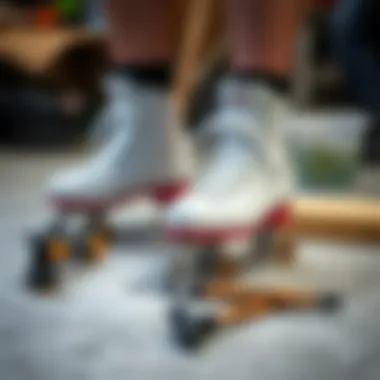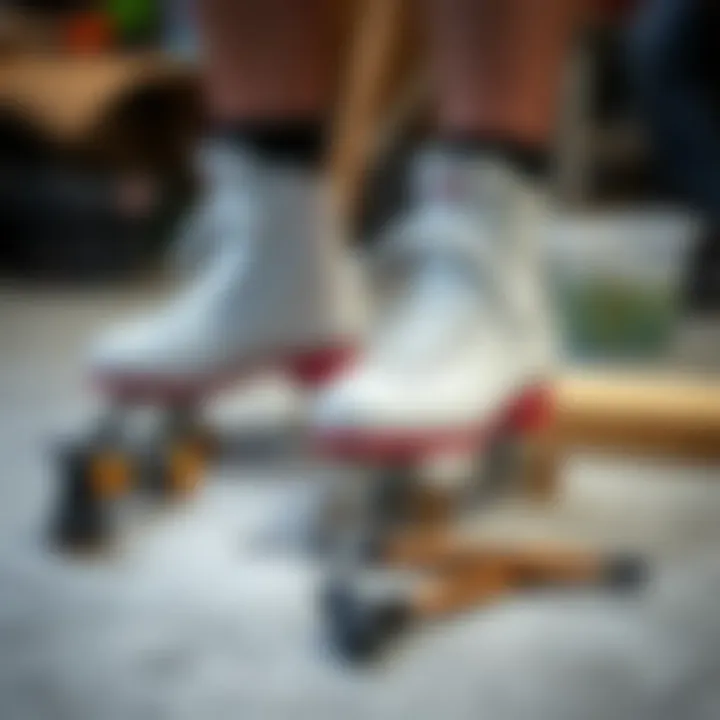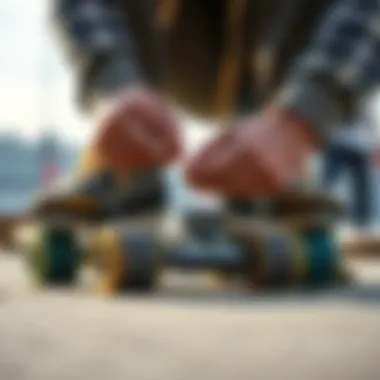Guide to Baking Skates at Home for Better Fit


Intro
Baking skates at home might sound like an odd concept at first. However, for seasoned skaters and newcomers alike, this process can make a world of difference when it comes to comfort and performance on the rink. When you lace up a pair of well-fitted skates, you can truly feel the difference in your stride, stability, and overall enjoyment.
So, why is baking necessary? Well, the primary reason is to customize the fit of your skates. Brand new skates often have stiff parts that need to mold to the contours of your feet. By applying heat, the materials become softer, allowing them to shape around your feet more comfortably. This means less chafing and better support, a recipe for success whether you’re racing, doing tricks, or simply having fun with friends.
In this guide, we will delve into the ins and outs of baking your skates at home. We will not only highlight the benefits of the process but also provide you with detailed step-by-step instructions to help you tackle it confidently. Throughout this exploration, we’ll address the tools needed, common pitfalls, and solutions—as well as the financial impacts of baking your skates versus seeking professional help from a retailer.
Get ready to enhance your skating experience, making those blades feel like an extension of yourself. Whether you are planning to glide onto the ice or fly around a skate park, the technique of baking skates will undoubtedly improve your performance.
"You can't skate with shoes that don't fit; it's like trying to dance in two left feet."
As we go deeper into this guide, expect to find an array of applicable insights and tips tailored to make you confident in customizing your skates from the comfort of home.
Preamble to Skate Baking
When it comes to enhancing a skating performance, the importance of a properly baked skate cannot be overstated. Skate baking essentially involves heating the skate boots to mold them precisely to the unique contours of your feet. This process doesn't just improve comfort; it can directly impact how you skate. A skate that fits like a glove can enhance your control on the ice, giving you the edge during competition or leisurely outings alike.
The art of skate baking lies in its ability to customize. Unlike factory settings where skates can feel stiff and too roomy in some areas, baking achieves that tailor-made feel that every skater strives for. Additionally, skates can sometimes need a little extra help to adapt to the specific movements required in skating – be it speed, agility, or stability. Utilizing the baking method can be the tipping point in achieving that elusive balance.
In this guide, we’ll break down the intricacies of skate baking, emphasizing why understanding this process is crucial for any dedicated skater. Whether you’re looking to maximize comfort or enhance performance, knowing how to bake skates is essential. The journey begins with grasping what skate baking is and why it matters.
Understanding Skate Baking
Skate baking involves the use of heat to soften the materials in your skate boots which allows them to mold to your foot better. Generally, the boot contains different elements like synthetic materials or leather, which have unique behaviors when exposed to heat. This baking process uses a specific temperature range that optimally softens these materials without risking damage.
Here are the key elements to understanding skate baking:
- Materials: Each skate boot is designed with varying materials, requiring knowledge to properly heat and shape them.
- Temperature Control: Maintaining the right temperature is crucial. Too hot can damage the boot, while too cold may not provide the desired effect.
- Heating Duration: The length of time skates spend in the oven directly affects how well they will fit.
"The right fit leads to better performance, and the secret sauce is often found in baking your skates."
Importance of a Proper Fit
Getting the right fit is essential for any skater, novice or experienced. A well-fitted boot provides excellent support and helps to prevent injuries. When skates fit properly, the skater experiences reduced friction and discomfort, allowing them to focus on their technique without distractions.
- Performance Enhancement: A customized fitting can enhance your responsiveness on the ice.
- Injury Prevention: Poorly fitted skates can lead to blisters, numbness, or in severe cases, more serious injuries.
- Confidence Boost: With the right fit, skaters feel more secure in their movements, allowing them to push harder and enjoy their time on the rink.
Ultimately, the connection between foot and skate translates to performance. An ill-fitting skate can hinder your potential. Thus, the baking process is a small step that pays significant dividends.
Investing time into baking your skates properly ensures you are getting the most out of your equipment and can be a game-changer in how you experience skating.
Materials Required for Baking Skates
Understanding what materials are needed to bake skates is vital for a successful process. The right components not only ensure a comfortable fit but also elevate your overall skating experience. Each material serves a specific purpose and plays a crucial role in guaranteeing that the skates are safely and effectively baked.
Skate Type and Construction
The type of skates you own will inherently influence the baking process. Skates can be classified into various categories—recreational, sport, or professional—each with distinct construction characteristics. Most skates today often feature composite materials designed for performance enhancement. This is a critical consideration when baking skates, as the heat can have varied effects based on the skate’s design.
Typically, the inner liner contains foam that molds around your foot. If you own skates with a heat-moldable shell, you’re in luck. These varieties are designed specifically for this process and can deliver a custom fit that’s both snug and comfortable. In contrast, skates with rigid shells, such as certain higher-end brands, might not respond as favorably. So, knowing your skate’s specific type and material is foundational to preparing for the baking step.
This information can be found on manufacturer websites, or in skating manuals available at local skate shops. Trying to bake a skate that isn’t designed for it may not yield the results you’re looking for.
Baking Oven Considerations
Baking skates at home requires the right oven. You need a convection oven that heats evenly, ensuring all parts of the skate receive adequate warmth. An oven that’s too hot or has uneven temperature zones can cause damage, resulting in warped shells or overly soft interiors. Therefore, it's wise to consider the following:
- Oven Type: Use a conventional oven rather than a toaster oven, as the smaller space can lead to hotspots.
- Temperature Accuracy: Invest in an oven thermometer if your oven lacks a reliable gauge. Some models can be off by a few degrees, which can affect the baking.
- Ventilation: Ensure your baking area is well-ventilated. While it’s not generally a hazardous activity, some may find it uncomfortable to be in a hot kitchen for extended periods.


According to baking.org, the best temperature for most skates lies between 175°F and 185°F. Keeping this in mind can save you a lot of headaches down the line.
Protective Gear and Accessories
Safety should never take a backseat when baking skates. The heat can reach levels that might burn your skin or damage your household items. Incorporating some protective gear is wise. Key items include:
- Oven Mitts: A good pair of thick oven mitts is essential. It’s easy to underestimate how heavy the skates can feel when hot.
- Heat-Resistant Surface: You’ll need a safe surface to place the skates once they come out of the oven. A silicone baking mat serves well as it can handle temperature extremes.
- Timer: A reliable timer will help keep track of your baking time, ensuring you do not leave the skates in the oven longer than needed.
"Proper preparation prevents poor performance." - Remember this adage as you gather your materials and prepare to create a custom fit!
Preparing for the Baking Process
Baking your skates at home is not just about tossing them in the oven and hoping for the best. It requires a strategic approach to ensure that you achieve a snug fit that enhances your skating performance. This section will delve into two essential components that set the stage for successful skate baking: choosing the right temperature and effective time management and planning.
Choosing the Right Temperature
When it comes to baking skates, the temperature of your oven plays a crucial role in how they mold to your feet. Setting the right temperature is a delicate balancing act; too high, and you risk damaging the materials, too low, and the heat may not be sufficient to provide the desired flexibility.
Most skates require baking at a temperature between 180°F and 200°F. To ensure precision:
- Use an oven thermometer to check that the temperature is consistent.
- Preheat the oven while you prepare your skates. This will eliminate temperature fluctuations that can affect the baking process.
Understanding why your specific skate type has these requirements is equally vital. For instance, the material composition of the skate boot affects how it reacts to heat. For skates made of synthetic materials, a lower temperature may be more beneficial. Conversely, those with heat-moldable foam may adjust better at higher temperatures. This variability means one size does not fit all, and skaters should refer to their skate manufacturer’s guidelines for optimal results.
"Baking skates at the appropriate temperature not only enhances comfort but also significantly improves control on the ice."
Time Management and Planning
Just as with temperature, timing is everything in the baking process. Proper time management ensures that each phase of the procedure is adequately observed without rushing or stalling. Skates typically bake for 10 to 15 minutes. However, this can vary based on the skate material and oven specifications.
To avoid mishaps during skate baking, consider these tips:
- Establish a Timer: Always use a timer to remind you when to check the skates rather than relying on memory. This way, you can stop overbaking before any damage occurs.
- Simultaneous Tasks: Use the time you have while the skates bake to prepare for the next steps, such as making sure your protective gear is ready for use post-baking.
- Test for Fit Post-Baking: Timing offers an opportunity to plan ahead and have a test fit handy. Be sure to wear the exact socks you'll use when skating to ensure an accurate fit.
Incorporating a well-thought-out plan minimizes the occurrences of unexpected results while enhancing your confidence in the process. Good timing essentially means better performance on the ice, as it optimizes how the skates shape around your foot, leading to a comfortable fit.
In summary, laying solid groundwork through temperature regulation and careful timing forms the backbone of a successful skate baking session. As you meld these elements into your baking routine, you’re paving the way for a seamless and enjoyable skating experience.
Step-by-Step Guide to Baking Skates
The process of baking skates is an essential practice for those serious about their skating performance and comfort. By heating the skate materials, you enable them to mold to the unique shape of your foot, creating a tailor-made fit that enhances both responsiveness and reduces discomfort. This section lays out a structured approach to effectively execute the skate baking process at home. When done correctly, it not only improves how your skates feel but also can contribute to prolonged durability. Let's delve into the key steps that can transform your skates from a store-bought item into a personalized extension of your body.
Preheat the Oven
One of the first steps in the actual baking process is to preheat your oven. Some skaters might underestimate this step, thinking "it doesn’t matter how hot the oven is as long as they get baked." However, consistency in temperature is key. A moderate temperature, typically around 175-185 degrees Fahrenheit (80-85 degrees Celsius), helps create a balanced heat that gently warms the skates without causing any damage.
Tips for Preheating:
- Ensure your oven is clean; leftover debris can affect the temperature and, consequently, the baking process.
- Use an oven thermometer to confirm accuracy, as many built-in thermostats can be misleading.
- Preheat for at least 5 to 10 minutes to allow for even heat distribution.
Inserting the Skates
Once your oven reaches the desired temperature, it’s time to put the skates inside. Carefully place each skate upside down on the oven rack, eliminating any gas leaks or built-up oil that could cause odor. Make sure not to cramp them together; they need space to receive heat equally. Depending on the skate type, the baking time can vary from 10 to 12 minutes.
Important Considerations:
- Don’t leave the skates unattended, as overheating can lead to warped materials.
- Keep the skate laces and tongues in place to ensure they hold their shape while baking.
Monitoring the Baking Process


This is where attentiveness pays off. Set a timer to remind yourself to check on the skates periodically. You’re aiming for a consistent warm feel and, while you shouldn’t feel the need to pry them out early, it’s essential to assess often to make sure nothing is going amiss.
"It’s better to be safe than sorry" rings true here. If skates are starting to emit unpleasant odors or look too shiny, it’s time to remove them immediately.
Post-Baking Cooling Techniques
Once the skates are baked to perfection, the next critical step is cooling. Do not put them on your feet while they’re still hot. Instead, allow them to rest for at least 10 minutes. This cooling period helps the skate reintegrate its structure, cementing the adjusted shape into its materials.
- You can use a cooling rack, which facilitates better air circulation around them.
- Consider wearing them after cooling for a test fit or a light stretch in your home to assure the fit is just right.
In closing this section, the step-by-step guide is not just an instructional pathway but the cornerstone of achieving an effective fit. Proper procedures lead to optimal results, making all the difference in your skating experience.
Troubleshooting Common Issues
When diving headlong into the baking process, it's easy to imagine everything will go off without a hitch. However, just like any delicate task, skate baking can throw a curveball or two your way. This section addresses common issues that may arise, allowing aspiring bakers to navigate these roadblocks with a bit more finesse. Understanding these problems comes with a ton of benefits: it saves time, reduces frustration, and bolsters your confidence as you learn the ropes. Remember, knowledge is power, and being prepared for the unexpected can lead to a smoother baking experience.
Overbaking and Its Consequences
Overbaking skates is akin to burning toast. It can happen to the best of us. When skates are subjected to excessive heat or remain in the oven beyond the recommended time, the materials can soften or even warp. This primarily affects the boot structure, leading to long-term damage which could spell doom for your skating sessions.
Think about it: a boot that’s too pliable may not offer the support you need during those fast turns or jumps.
Signs of overbaking include:
- Unusual discoloration on the skate's surface.
- A rubbery feel upon inspection.
- Significant warping around the ankle area.
If you suspect your skates are overbaked, the road ahead isn’t all doom and gloom. While severe damage might be irreversible, it’s worth checking if they can still be salvaged by consulting a professional or considering options like heat moldable insoles.
Inadequate Fit After Baking
Imagine jamming your feet into shoes that just don’t fit right. The idea is cringeworthy, yet this can happen after baking skates if the process isn’t executed properly. An inadequate fit could lead to discomfort, reduced performance, or even injuries in extreme cases.
Some potential reasons for this misfit include:
- Improper Temperature: If the oven was too hot, the material might not mold correctly around your foot shape.
- Incorrect Baking Time: Leaving the skates in the oven for not long enough can mean they won't adequately conform to your unique foot shape.
If you find yourself struggling with a fit that leaves you feeling like Cinderella's ugly stepsister, try re-baking the skates, adjusting the time and temperature according to the guidelines for your specific skate type. Just take heed to avoid overbaking!
Material Damage and Repair
Sometimes, despite the best preparations, material damage can occur. This is particularly common with lower-quality skates or if the baking process didn’t align with the material’s specifications. You might encounter:
- Cracking: Often a sign of prolonged exposure to high temperatures.
- Delamination: This happens when the layers of the boot begin to separate.
Should you notice damage, don’t fret. Here are some steps to consider for repairs:
- Consult a Professional: It’s often the best bet. An experienced repair technician can assess the damages and offer appropriate solutions.
- DIY Fixes: For minor issues like superficial cracks, there are repair kits available at your local skate shop.
"A stitch in time saves nine"—this old adage rings true in skate maintenance. Regularly maintaining your skates can prevent minor issues from spiraling into costly rehabs.
By recognizing potential problems, you equip yourself to keep your skates in top shape, ensuring they serve you well on the ice.
Financial Considerations of Baking Skates
Discussing the financial aspects of baking skates at home gives us a clearer view of what this endeavor really entails. Many skaters may initially think about the cost of materials and equipment; however, those are only part of the equation. Understanding the overall financial picture provides insight into potential savings, as well as the value of investing in professional services when necessary.
With the rise of skate customization, it’s only natural skaters want their gear to align perfectly with their individual needs and preferences. The financial considerations of baking skates can influence the choices they make along the way, impacting not just their wallet but also their overall skating experience.
Cost-Effective Baking Options


When examining cost-effective baking options, skaters can explore various paths to achieve that perfect fit without breaking the bank.
Here are key aspects to consider:
- DIY Equipment: Many skaters already own a home oven or access to one. Rather than investing in expensive commercial skate baking ovens, adjusting your own home oven to the right temperature can yield a satisfying result.
- Use of Existing Accessories: Ensure you have all the necessary protective gear and accessories before diving into the baking process. You might find that everyday items—like a pizza stone for even heat distribution—can serve your purpose well without any extra cost.
- Local Shops Offering Renting Services: Some local skate shops offer skate baking as a service for a reasonable fee. Compare the costs, and see if it fits better within your budget to pay a small sum for professional injection heat than to invest heavily in equipment you might only use occasionally.
In essence, carefully evaluating the costs associated with DIY baking versus professional services can save skaters a good chunk of change without sacrificing quality.
Value of a Professional Service
Although baking skates at home can be economical, there are times when opting for a professional service significantly outweighs the DIY route. Here are some points to weigh:
- Expertise and Precision: Skilled technicians can ensure a proper fit that might be hard to achieve otherwise. Their experience in aligning the heat to the specific materials of the skates can prevent unnecessary damage usually associated with amateur attempts.
- Time-Saving: Professionals often have quicker turnaround times, allowing you to get back on the ice sooner without worrying about waiting for the oven to preheat or troubleshooting mishaps during a DIY process.
- Assessment of Additional Repairs: Pros can spot areas needing repairs or adjustments that skaters might overlook. If something seems amiss, they can address it on the spot, potentially saving you from further costs in the long run.
Ultimately, weighing the pros and cons is essential. In some cases, the small cost of a professional baking service may indeed prove to be a valuable investment in your skating performance and enjoyment.
Wrapping Up the Baking Process
Completing the baking process is not merely a formality; it's the closure of a meticulous journey that enhances both comfort and performance on ice. This stage solidifies the time and effort invested by confirming whether the skates meet the required standards of fit and functionality. In this section, we delve into the importance of testing the fit and maintaining the baked skates, both essential steps that help ensure longevity and performance.
Testing the Fit
Once the skates have cooled down after baking, it's time to assess their fit. Testing the fit is crucial for several reasons. First of all, a well-fitted skate can drastically influence skating technique. Comfort and support, especially during rigorous maneuvers, can elevate a skater's performance level. When testing the fit:
- Wear the Socks You Usually Use: The socks create the initial barrier between your foot and the boot, which can influence how snug or loose the skates feel.
- Lace Up Properly: Use the lacing technique that you would normally employ when skating. This helps simulate the exact conditions you'll face on the ice.
- Movement Assessment: Take a few strides on the floor. Look for any areas of pressure or discomfort. Make sure your toes just graze the front of the boot when standing, as this will shift when you lean into your stride.
If you find areas that need adjusting, don’t hesitate to re-bake them for a short period or consult a professional if you're unsure.
Maintaining Baked Skates
Maintenance is pivotal for the longevity of your skates post-baking. One might say they have a little dance with care and attention to keep them performing at their peak. Here are some tips for keeping those custom-baked skates in shape:
- Regular Cleaning: After each use, remove dirt and debris. A simple damp cloth can go a long way in preserving the material and aesthetic, ensuring that the skates remain as fresh as a daisy.
- Drying Practices: Never leave skates in direct sunlight or a confined space post-use. Instead, dry them naturally at room temperature for optimal integrity.
- Inspect Regularly: Look for signs of wear regularly. Check the blades, the boot stitching, and insoles for potential issues. Early detection could save you from a bigger headache down the road.
- Re-Baking When Necessary: If the skates start feeling looser due to wear, consider a process called "re-baking." It can help restore the shape and fit without significant investment.
- Use a gentle soap for tough grime, and avoid harsh cleansers that can damage the exterior.
A proactive approach to skate maintenance will not only extend their life but ensure that each skating session is enjoyable and effective, right down to the last glide.
"Proper care minimizes the need for repairs, ensuring each skating experience is as smooth as the last."
In the end, understanding the process of wrapping up the baking of skates and following through with vigilant maintenance lays the groundwork for an unparalleled skating experience.
The End on Custom Fit Advantages
In the realm of skating, the fit of your skates can make or break your experience. By baking your skates at home, you not only take control of the fit but also enhance your overall performance. A custom fit is paramount for anyone serious about skating, whether for recreational enjoyment or competitive endeavors. The right fit minimizes pressure points and distributes force evenly across the foot, which can be the difference between flying gracefully through a rink or stumbling awkwardly.
Enhanced Performance Outcomes
When skates fit like a glove, the outcome is evident. A snug fit allows for better energy transfer from the skater to the ice. The closer connection between the foot and the boot means that when you push off, the response is immediate and efficient. Skaters often notice improved balance and agility as they glide effortlessly. Moreover, a properly baked skate can reduce fatigue during long sessions, enabling skaters to push their limits without succumbing to discomfort.
The psychological impact also can't be ignored; when skaters feel comfortable and confident in their gear, they perform better.
Key benefits of enhanced performance outcomes:
- Improved maneuverability: A custom fit allows for precise movements.
- Stable feel: You’re less likely to roll your ankle with a proper fit.
- Increased speed: Energy is not wasted, bestowing an edge during critical maneuvers.
Long-Term Benefits of Proper Fit
Investing the time to bake skates for a perfect fit can pay dividends down the road. When skates are customized to your foot's unique shape, they can prolong the life of the product significantly. Instead of constantly battling with blisters or numbness due to ill-fitting skates, a properly baked pair reduces these worries. Additionally, a good fit means you won’t need to replace your skates as frequently, which is a financial boon for many skaters.
What’s more, a comfortable skate encourages regular practice, leading to improved skills over time. The long-term relationship between skates and skater can foster a sense of loyalty towards a particular brand or model, creating a deeper understanding of what works best for your style and technique.
In summary, the long-term benefits of investing in a proper fit include:
- Longevity of the skates: Skates not constantly worn down by bad fits.
- Enhanced skill development: Comfortable skates can motivate more frequent practice.
- Personal connection to gear: Developing familiarity with a personalized setup leads to better performance.
"A well-fitted skate is not just gear; it’s an extension of the skater’s ability to express their artistry on ice."
As you delve into the world of skate baking, remember that achieving a perfect fit is about more than just comfort. It’s about enabling your body to perform at its best. The completion of this fitting process wraps around both immediate enjoyment and long-term success in the sport.















